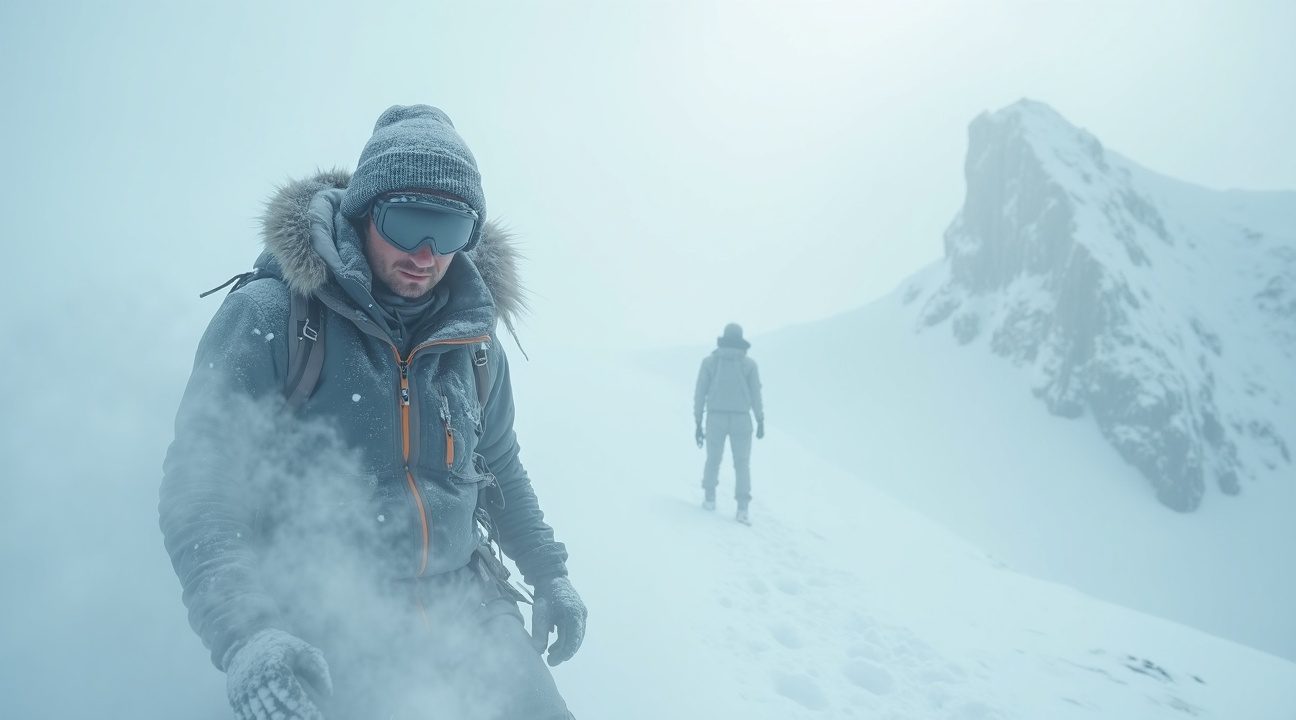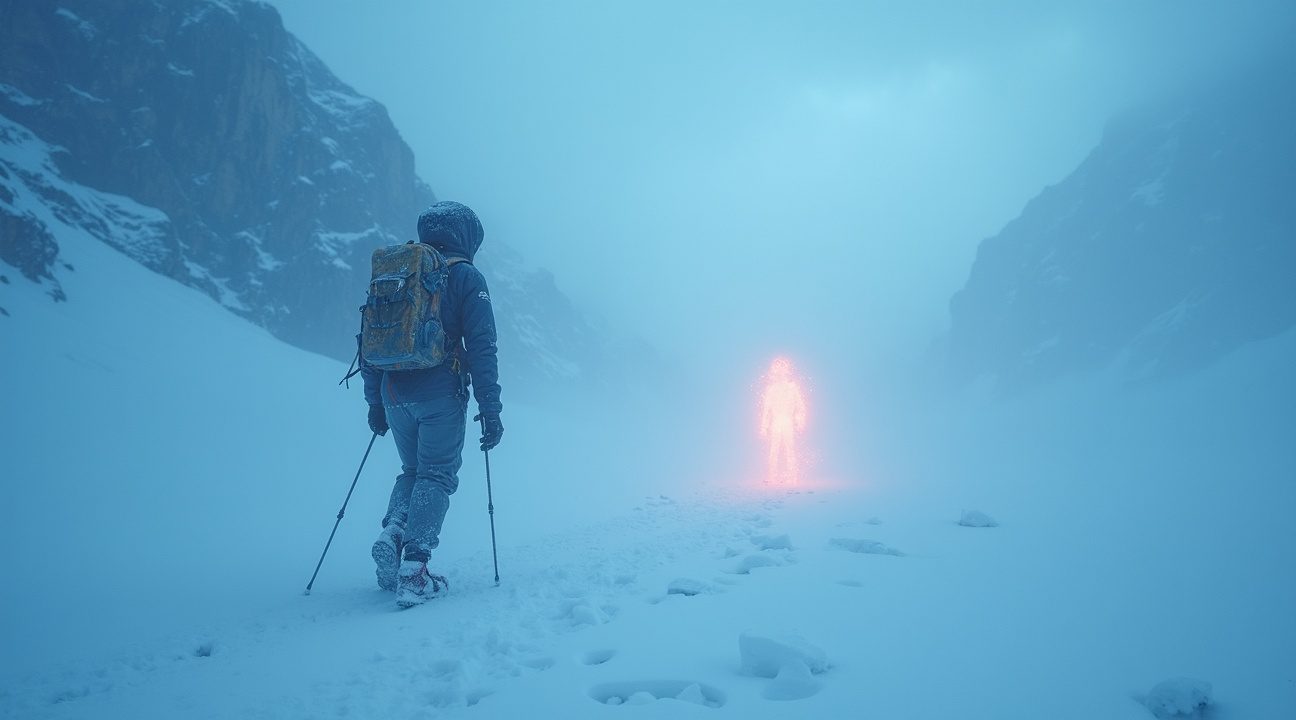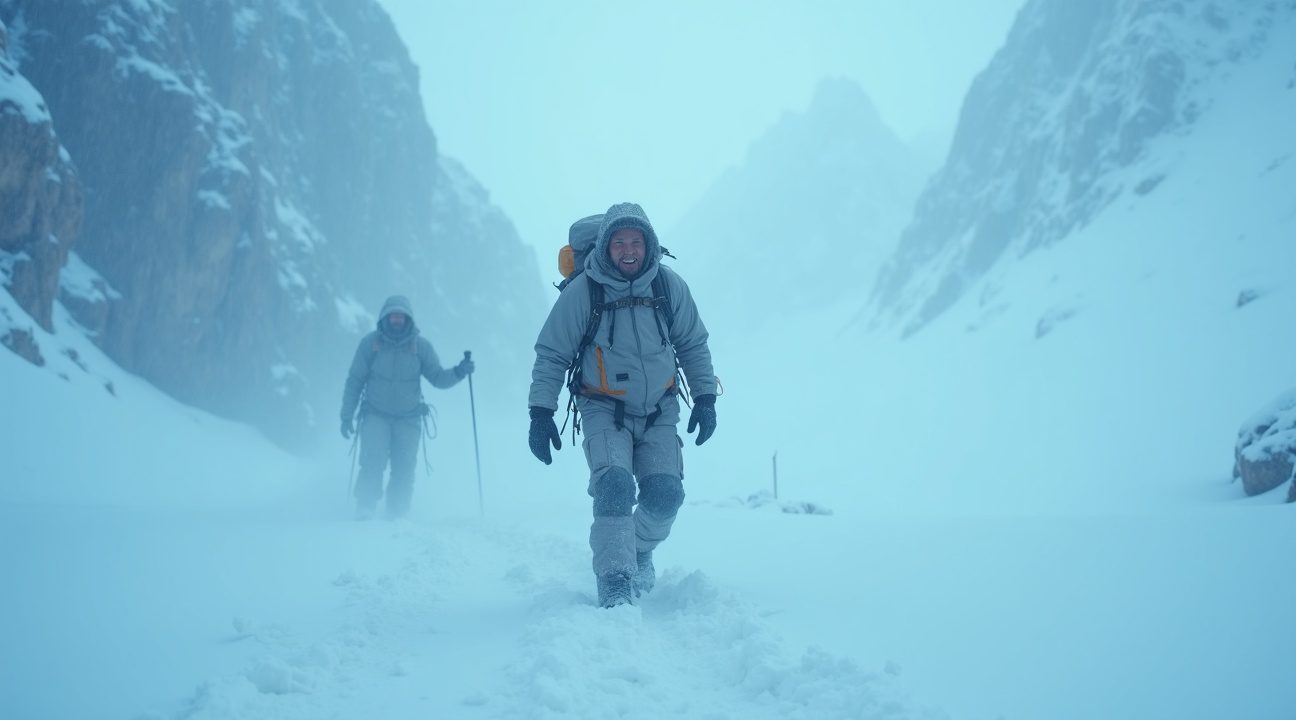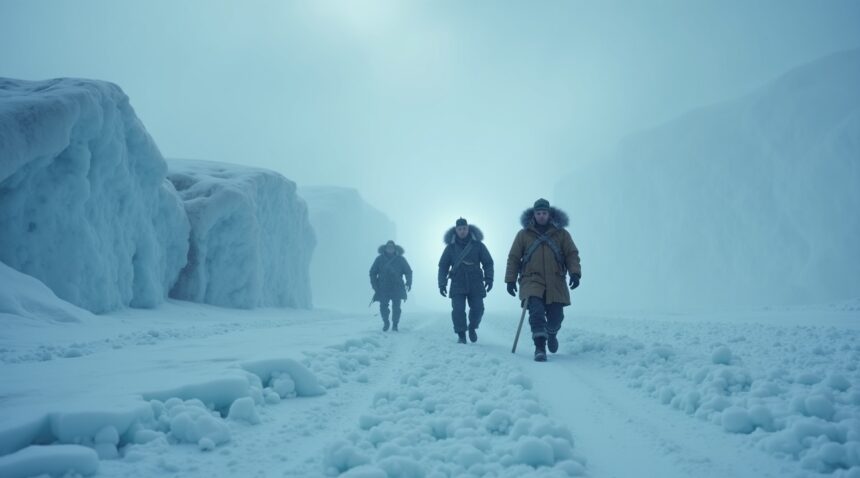Third man syndrome represents a fascinating psychological phenomenon where individuals facing life-threatening situations report sensing an invisible, benevolent presence that provides guidance and comfort during their darkest moments.
From Ernest Shackleton’s Antarctic expedition to modern mountaineering accidents, this mysterious experience has been documented across cultures and extreme environments, challenging our understanding of human consciousness under severe stress.
Key Takeaways
- Third man syndrome typically occurs during solitary, life-threatening situations involving extreme physical and psychological stress, particularly in isolated environments like mountains, polar regions, or combat zones.
- The phenomenon manifests as a felt presence, comforting voice, or invisible companion that provides practical survival guidance rather than abstract comfort, with experiences remaining remarkably consistent across different cultures and situations.
- Scientists believe the syndrome results from the brain’s natural survival response to extreme conditions like oxygen deprivation, exhaustion, and sensory deprivation, with research showing specific brain regions involved in creating these perceptions.
- Therapists now incorporate elements of the third man effect into trauma treatment, using guided imagery of supportive presences to help PTSD patients develop internal coping resources and emotional stability.
- The phenomenon remains scientifically controversial because researchers cannot ethically recreate the life-threatening conditions necessary to study it, leaving most evidence based on personal accounts rather than controlled laboratory data.
Further Exploration
To learn more about historical accounts and recent research into third man syndrome, you can read this detailed article from The Guardian that explores notable incidents and the psychological theories behind them.
When Ernest Shackleton’s Crew Felt a Mysterious Fourth Presence in Antarctica
The icy wilderness of Antarctica became the backdrop for one of history’s most compelling accounts of the third man syndrome during Ernest Shackleton’s harrowing 1916 expedition. Trapped in crushing ice floes, Shackleton and his crew faced months of extreme hardship that pushed human endurance to its absolute limits. During their desperate journey across the frozen continent, something extraordinary happened that would forever change how people understand survival psychology.
Shackleton himself reported feeling the presence of an unseen fourth companion accompanying his three-man team as they traversed the treacherous Antarctic landscape. Exhausted, malnourished, and fighting against brutal cold, the crew members consistently felt they weren’t alone despite being certain only three of them remained together. This mysterious presence seemed to guide them through their darkest moments, offering comfort and direction when their situation appeared hopeless.
Literary Recognition and Cultural Impact
T.S. Eliot immortalized this phenomenon in his masterpiece “The Waste Land,” directly referencing the Antarctic experience and cementing the phrase “third man” in literary history. Eliot’s powerful verses captured the essence of this supernatural encounter, transforming a survival story into a profound meditation on human resilience and the mysteries of consciousness under extreme stress.
The poet’s recognition elevated Shackleton’s account from mere expedition folklore to a recognized psychological phenomenon worthy of serious study. Literature provided the perfect vehicle for exploring these experiences that seemed to exist at the intersection of reality and imagination.
Documented Cases Across History
Shackleton’s crew wasn’t alone in experiencing this phenomenon. Mountaineer Frank Smythe encountered a similar presence during his 1933 Everest expedition, feeling so certain of his invisible companion that he actually broke his chocolate ration in half to share. The experience felt completely real to Smythe, who maintained throughout his life that something genuinely accompanied him during those critical moments at extreme altitude.
Polar explorer Peter Hillary has also documented similar encounters, adding credibility to the pattern of experiences reported in extreme environments. Shipwreck survivors have consistently reported similar phenomena, suggesting that life-threatening situations create specific conditions that trigger these mysterious encounters.
John Geiger has spent considerable time documenting hundreds of these cases throughout history, collecting accounts from various extreme situations. His research reveals common threads among survivors who report feeling guided by an unseen presence during their most desperate moments. These cases span different cultures, time periods, and geographic locations, suggesting a universal human response to extreme stress rather than isolated incidents.
The consistency of these reports across different contexts strengthens the case for third man syndrome as a legitimate psychological phenomenon. Survivors describe remarkably similar experiences despite having no prior knowledge of others’ accounts, lending authenticity to their testimonies. Modern psychology now recognizes these experiences as the brain’s remarkable ability to create protective mechanisms during life-threatening situations.
Understanding these historical accounts helps explain how the human mind adapts to extreme circumstances, potentially activating survival mechanisms that manifest as perceived companionship. Whether viewed through scientific, spiritual, or psychological lenses, the documented experiences from Shackleton’s expedition onward demonstrate humanity’s incredible capacity for resilience in the face of seemingly impossible odds.
These accounts continue to fascinate researchers and survivors alike, offering insights into both human psychology and the extraordinary circumstances that can trigger such profound experiences. The legacy of Shackleton’s Antarctic encounter lives on, inspiring continued investigation into one of survival psychology’s most intriguing mysteries.
https://www.youtube.com/watch?v=Z1S_U1uZXWs
The Invisible Guardian That Appears in Life-or-Death Moments
When faced with extreme peril, some people experience an extraordinary phenomenon that challenges our understanding of consciousness and survival psychology. Third man syndrome, also known as third man factor or third person syndrome, describes the vivid sensation of an unseen, benevolent presence that appears during life-threatening situations.
This invisible guardian doesn’t manifest as a physical apparition but rather as a powerfully felt presence that seems to offer guidance and comfort when it’s needed most. People experiencing this phenomenon often report hearing a calming voice, sensing someone standing beside them, or receiving specific survival instructions that help them navigate their crisis. The presence feels undeniably real, yet remains completely invisible to others.
How This Protective Presence Manifests
The third man factor typically appears in several distinct ways during extreme stress situations:
- A comforting voice that provides step-by-step survival instructions
- A felt presence walking alongside the person, offering emotional support
- Mental images or visions of a protective figure guiding them to safety
- An overwhelming sense of calm that replaces panic and fear
- Clear, rational thoughts that seem to come from an external source
These manifestations consistently share common characteristics across different cultures and situations. The unseen presence always appears benevolent, never threatening or malicious. It provides practical help rather than abstract comfort, often delivering specific information about escape routes, survival techniques, or immediate actions needed to stay alive.
Survival psychology researchers have documented this phenomenon across diverse extreme situations, from mountain climbing accidents to combat zones. The third man syndrome seems particularly common during prolonged exposure to danger, severe physical exhaustion, or when individuals face seemingly impossible survival challenges.
What makes this experience remarkable isn’t just its frequency among survivors, but its consistency. People from different backgrounds, cultures, and belief systems describe remarkably similar encounters with their guardian angel-like presence. They report feeling guided by something beyond their normal conscious awareness, something that possessed knowledge or perspective they didn’t have access to themselves.
The sensation typically fades once the immediate danger passes, leaving individuals with vivid memories of their encounter but often struggling to explain exactly what happened. Many describe feeling protected by forces beyond their understanding, while others interpret the experience through religious or spiritual frameworks.
This phenomenon raises fascinating questions about human consciousness under extreme stress and the mind’s remarkable ability to access resources for survival that remain hidden during normal circumstances.
Why Mountaineers and Extreme Survivors Experience This Phenomenon Most
Third man syndrome appears most frequently in individuals who face extreme conditions alone, particularly mountaineers and other adventurers who push themselves to their physical and psychological limits. These experiences often occur in specific types of environments and under circumstances that share common characteristics.
High-Risk Environments Create Perfect Conditions
Mountaineers face a unique combination of factors that make them particularly susceptible to this phenomenon. The high altitude reduces oxygen levels to the brain, while extreme cold and exhaustion create additional physiological stress. Mountains, polar regions, deserts, and open seas all share similar traits: they’re isolated, sensory-deprived environments where help is far away and survival depends entirely on individual resilience.
Soldiers in combat zones, sailors on solo voyages, and astronauts in space also report these experiences. Each situation involves prolonged stress, isolation from normal social contact, and life-threatening circumstances. Accident victims trapped alone — whether in collapsed buildings, crashed vehicles, or remote locations — frequently describe sensing an invisible companion during their ordeal.
The Solitary Factor Makes All the Difference
What’s particularly striking about third man syndrome is how rarely it occurs in group situations. Even when multiple people face the same extreme conditions together, they don’t typically report sensing additional presences. The phenomenon seems specifically tied to solitary experiences where individuals must rely entirely on their own resources.
Travel experiences with companions often provide the social support and shared reality that appears to prevent these perceptual shifts. Trauma survivors who experience the phenomenon almost always describe being alone during their crisis, whether physically separated from others or psychologically isolated despite being in a group.
The brain’s response to extreme stress appears to manifest differently when social connections are completely severed. Mountaineers climbing solo face this isolation more intensely than those in other extreme sports. They often spend days or weeks with minimal human contact, fighting altitude sickness, exhaustion, and the constant threat of death. This combination of physical stress and profound isolation creates the perfect storm for the brain to generate a comforting presence when none exists.
Modern technology hasn’t eliminated these experiences either. Even with satellite phones and GPS devices, the fundamental isolation remains. Climbers still face hours or days where they must rely solely on their own judgment and endurance, creating the psychological conditions where third man syndrome emerges as a survival mechanism.

What Science Says About the Brain’s Response to Extreme Stress
Most researchers propose third man syndrome represents a natural survival response—a psychological coping mechanism the brain activates to manage overwhelming trauma, stress, or isolation. I find this explanation compelling because it suggests our minds possess built-in protective mechanisms that emerge during life-threatening situations.
Physical Triggers Behind the Phenomenon
The syndrome appears linked to several physiological factors that stress the human body beyond normal limits. Scientists have identified:
- Sensory deprivation
- Exhaustion
- Low blood glucose
- High-altitude cerebral edema
- Cold stress
These conditions share a common thread—they all compromise normal brain function while placing individuals in extreme danger.
University of Lausanne researchers made a breakthrough discovery when they artificially induced the sensation by electrically stimulating the left parietotemporal junction. This brain region manages sensory integration, suggesting the phenomenon stems from disrupted neural processing rather than supernatural forces. Professor Olaf Blanke’s work demonstrates how specific brain areas, when affected by stress or stimulation, can create the vivid sensation of an invisible companion.
The Debate Between Science and Spirituality
While neuroscientists offer biological explanations, many survivors maintain different beliefs about their experiences. Some believe they encountered a guardian angel, ghost, or supernatural guide during their darkest moments. This perspective can’t be easily dismissed, particularly given the profound impact these encounters have on those who experience them.
The phenomenon features orderly guidance rather than chaotic hallucinations, which distinguishes it from typical stress-induced mental disturbances. Survivors consistently report receiving practical, life-saving advice from their mysterious companion. This organized nature of the experience puzzles researchers and suggests the brain’s response involves more complex mechanisms than simple hallucination.
I notice mainstream psychology still struggles to fully explain third man syndrome. The phenomenon challenges conventional understanding of how consciousness operates under extreme stress. While electrical stimulation experiments provide valuable insights, they don’t capture the complete picture of why some people experience detailed conversations and emotional support from their invisible companion.
Current research suggests technological advances might eventually help us better understand these neural processes. Scientists continue investigating how extreme environments affect brain function, particularly in regions responsible for self-awareness and social cognition. The mystery persists because the experiences feel absolutely real to those who have them, yet remain difficult to study under controlled laboratory conditions.

How Therapists Now Use the Third Man Effect to Help Trauma Patients
Therapists have discovered that elements of the third man experience can serve as powerful tools in trauma therapy. I’ve observed how mental health professionals now incorporate the concept of imagined supportive presences into their treatment approaches, particularly when working with patients who struggle with PTSD and other trauma-related disorders.
Therapeutic Applications of Support Imagery
Mental imagery techniques that draw from third man experiences help patients create internal resources for managing distress. Clinicians guide their clients through exercises where they visualize comforting, protective figures who offer strength during moments of overwhelming anxiety or flashbacks. This approach taps into the same psychological mechanisms that spontaneously generate helpful presences during extreme survival situations.
The process typically involves teaching patients to consciously invoke these supportive mental images when they feel triggered or unsafe. Unlike traditional grounding techniques that focus on physical sensations, support imagery creates an internal companion that provides emotional stability. Patients often report feeling less isolated and more capable of managing their symptoms when they can access these imagined allies.
Benefits for PTSD and Trauma Recovery
PTSD coping strategies that incorporate third man-inspired techniques show promising results in clinical settings. Several factors make this approach particularly effective for trauma survivors:
- The imagined presence provides consistent availability, unlike human support systems that may be limited
- Patients maintain control over the supportive figure, reducing feelings of helplessness common in trauma
- The technique can be used discreetly in public situations where traditional coping methods might draw attention
- Support imagery helps counter the isolation and disconnection that often accompany trauma disorders
Trauma therapy sessions that include these visualization exercises help patients rebuild their sense of internal safety. I’ve noticed that clients who practice support imagery often develop stronger resilience against triggers and show improved emotional regulation over time. The technique seems especially helpful for individuals who experienced trauma in isolation or who struggle to trust others due to their experiences.
Some therapists combine this approach with other evidence-based treatments like cognitive behavioral therapy or EMDR. The imagined supportive presence can serve as a stabilizing resource during more intensive therapeutic work, helping patients feel grounded as they process difficult memories. While technology continues advancing in various fields, these fundamental human psychological phenomena remain valuable therapeutic tools.
Mental health professionals emphasize that success with support imagery requires practice and patience. Patients typically start with brief visualization exercises and gradually extend the duration as their skill develops. The supportive figure might evolve over time, sometimes taking the form of deceased loved ones, spiritual guides, or entirely fictional characters that represent safety and strength.
Clinical reports suggest that trauma patients who master these techniques often experience reduced hypervigilance and improved sleep quality. The internal support system created through imagination can provide comfort during nighttime hours when trauma symptoms frequently intensify. Many individuals find they can call upon their imagined ally during panic attacks or dissociative episodes, helping them maintain connection to the present moment.
This therapeutic application represents a fascinating bridge between extreme survival psychology and everyday mental health treatment. By studying how the human mind naturally creates supportive presences during crisis, therapists have developed practical tools that help trauma survivors reclaim their sense of agency and hope. The third man effect, once considered merely a curious survival phenomenon, now offers genuine healing potential for those recovering from psychological wounds.

Why This Phenomenon Remains Scientifically Controversial
Third man syndrome faces significant scientific scrutiny because researchers can’t ethically recreate the life-threatening conditions where these experiences typically occur. I can’t imagine any ethics committee approving studies that deliberately place people in mortal danger just to observe whether they experience a guiding presence. This fundamental barrier leaves scientists with limited options for controlled research.
The evidence pool consists almost entirely of personal accounts rather than laboratory data. Survivors share remarkable stories of mysterious companions who guided them to safety, but these testimonies lack the controlled variables that scientific methodology demands. Each account carries the weight of extraordinary circumstances, yet they don’t translate easily into measurable phenomena that researchers can analyze systematically.
The Academic Divide
Mainstream psychology maintains a cautious stance toward third man syndrome despite hundreds of documented cases spanning decades. I find it fascinating that such a consistently reported phenomenon struggles for academic recognition. The scientific community remains split on whether these experiences represent:
- Neurological responses to extreme stress and oxygen deprivation
- Psychological coping mechanisms activated during life-threatening situations
- Spiritual or metaphysical encounters beyond current scientific understanding
- Hallucinations triggered by specific brain chemistry changes under duress
Each explanation attracts its own supporters, but none has gained sufficient evidence to achieve widespread acceptance. Neuroscientists point to brain imaging studies showing how extreme conditions affect perception and cognition. Psychologists emphasize the mind’s remarkable ability to create protective mechanisms during trauma. Meanwhile, some researchers argue that dismissing these experiences entirely overlooks potentially important human capabilities we don’t yet understand.
The controversy deepens because third man syndrome doesn’t fit neatly into existing scientific categories. Unlike other stress responses that researchers can study safely, this phenomenon emerges only during genuine survival situations. I’ve noticed that even sympathetic scientists struggle with the challenge of investigating something that appears exclusively during unrepeatable, life-threatening moments.
Modern technology offers some hope for future research. Advances in brain monitoring could potentially capture neurological activity during extreme situations, though ethical concerns persist. Some researchers suggest studying extreme athletes or military personnel who regularly face dangerous conditions, but these scenarios rarely match the desperation and isolation that typically trigger third man experiences.
The scientific controversy continues because the phenomenon sits at the intersection of neuroscience, psychology, and philosophy. Each field brings different methodologies and assumptions, making consensus difficult to achieve. Until researchers develop new approaches that balance scientific rigor with the unique nature of survival situations, third man syndrome will likely remain on the fringes of mainstream scientific discourse.

Sources:
Deseret News – Third Man Syndrome: Spiritual Phenomenon or Survival Mechanism
EBSCO – Third Man Syndrome Research Starters
El País – Third Man Syndrome: What Is the Strange Presence That Assists Us in Life-Or-Death Moments?
Adventure Journal – The Mysterious, Ghostly Third Man Who Visits Explorers in Distress
Wikipedia – Third Man Factor
Wilderness & Environmental Medicine Journal
IFLScience – Third Man Syndrome: In Life-Or-Death Scenarios, Survivors Report A Helpful Person Appearing


